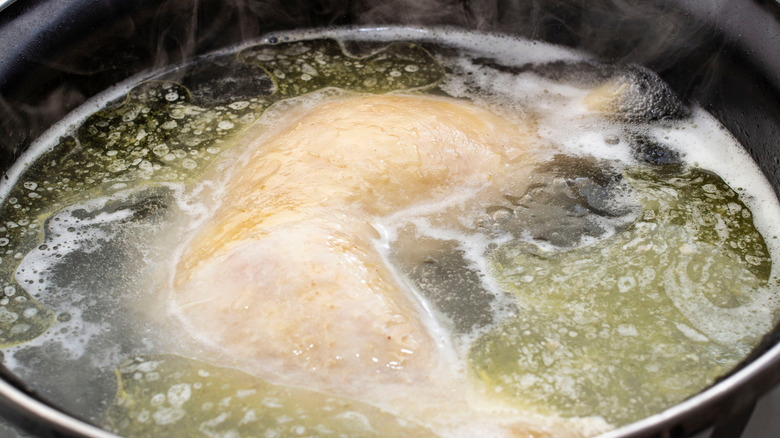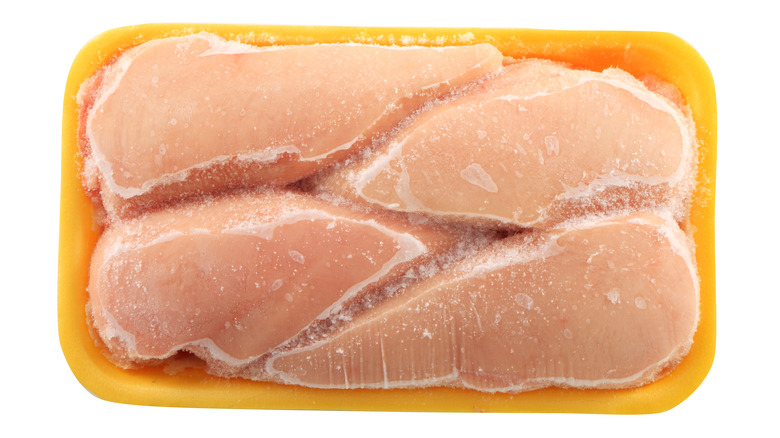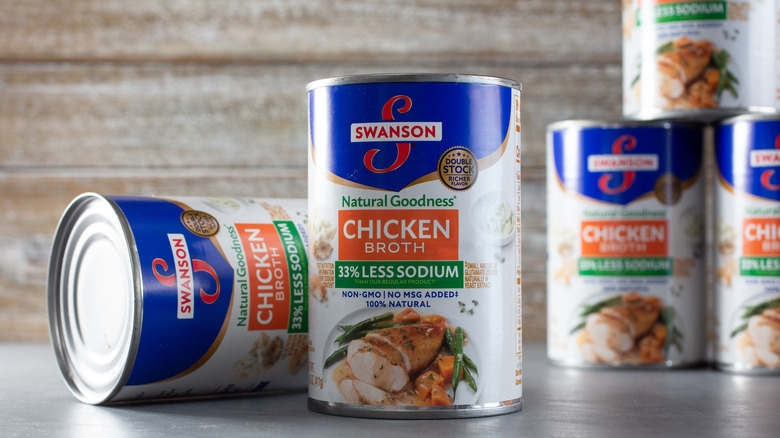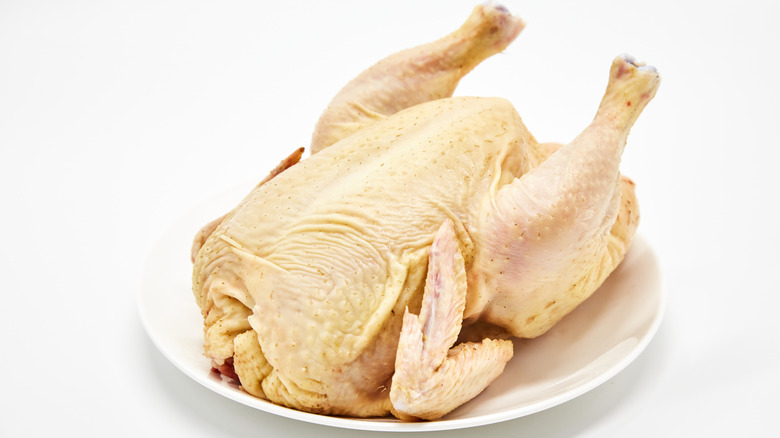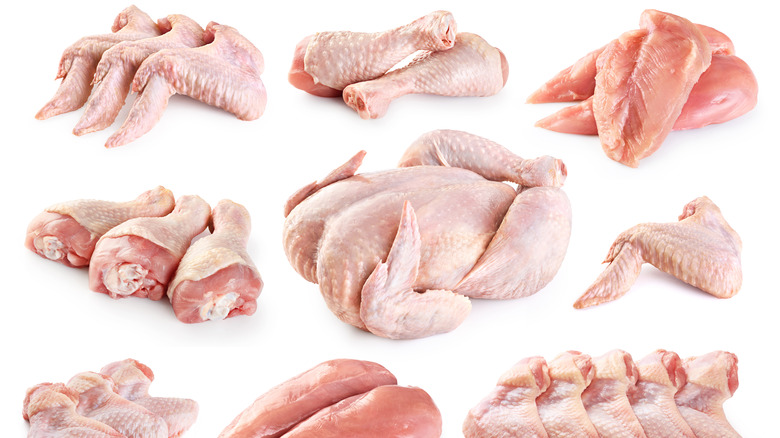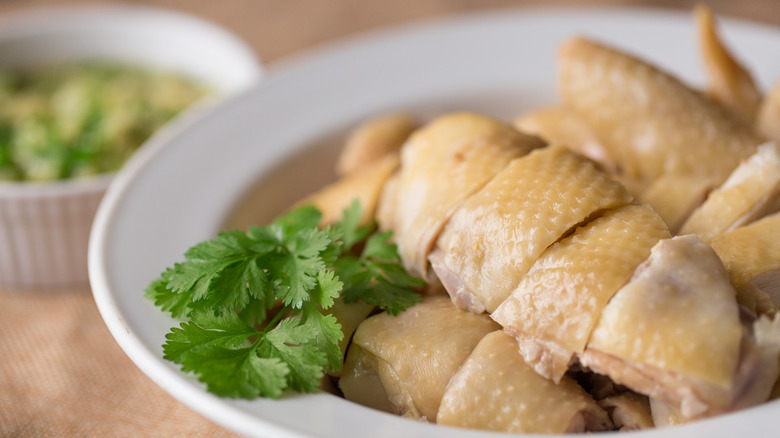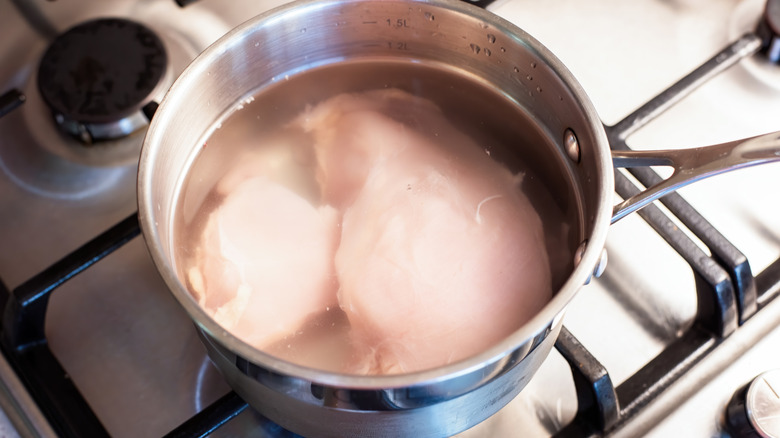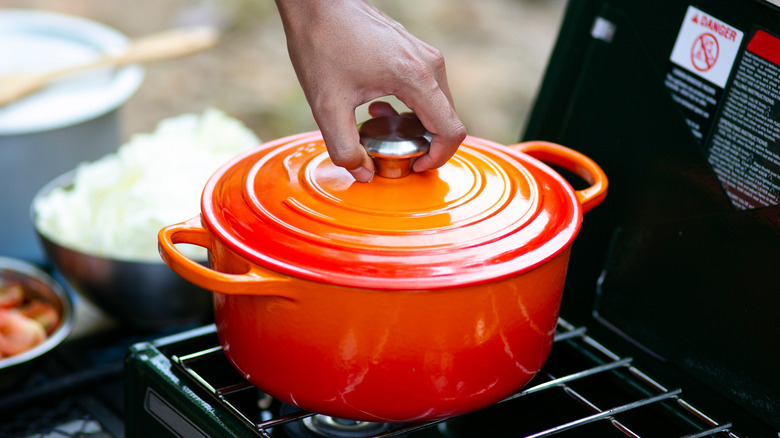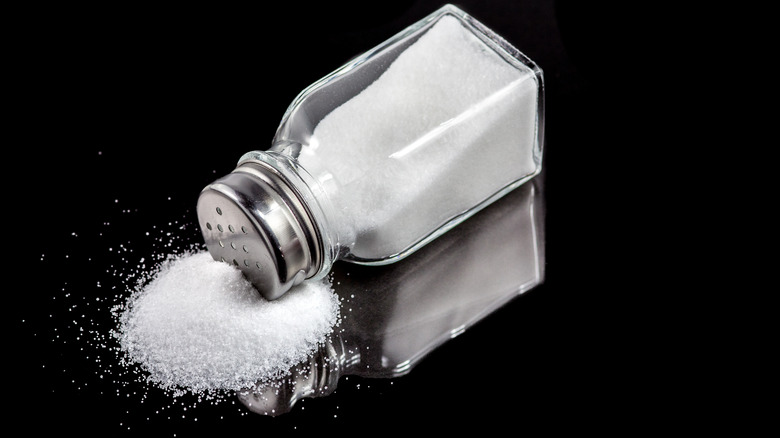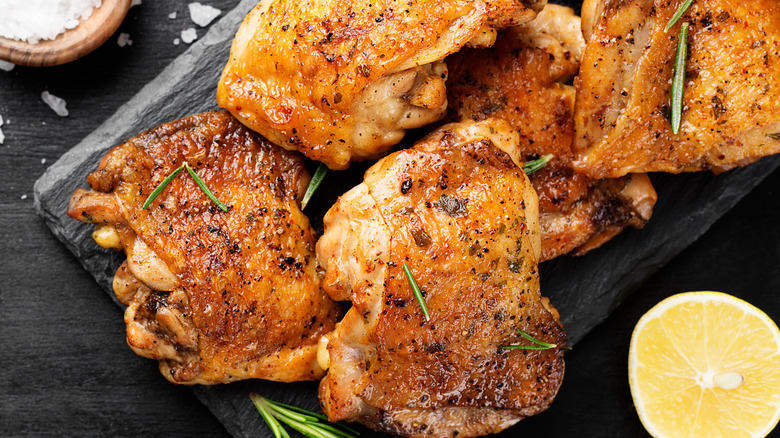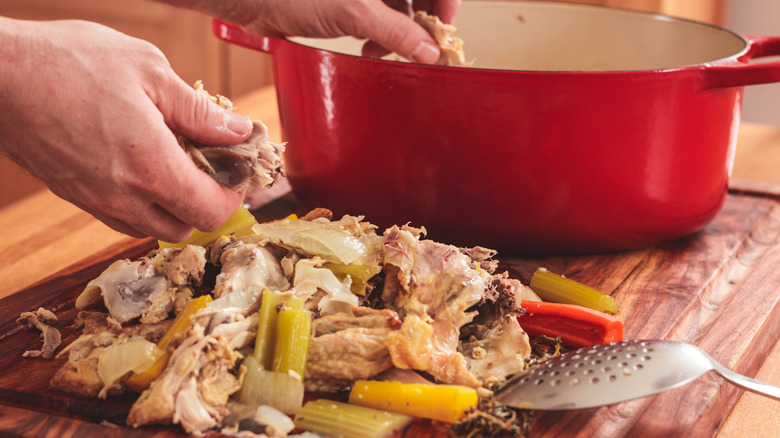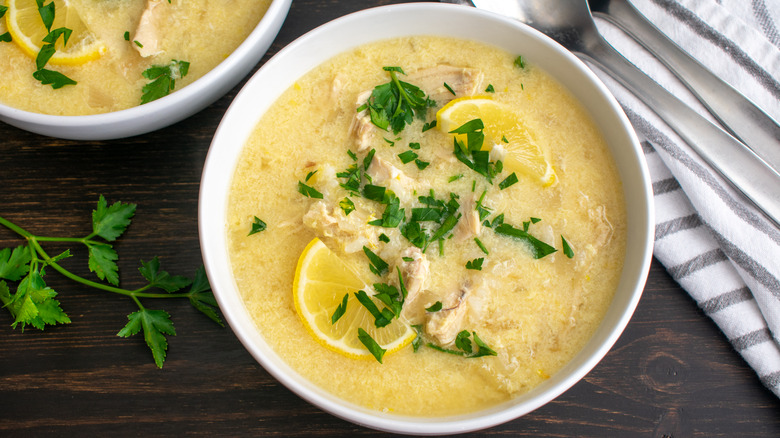Here's The Right Way To Boil Chicken
Boiling a chicken sounds so simple, but when you actually set out to do it, you soon find out how much you don't know about the right way to boil a chicken. Everyone seems to have their own recipe, from plain breasts boiled quickly in water to adding an array of vegetables and herbs and leaving it to simmer for hours (via Barefoot Contessa). Boiling chicken is one of the healthiest ways to prepare it and is perfect for creating a stockpile of pulled chicken, which you can then eat as is or use for recipes like green chile chicken stew.
What's really great about boiling chicken is that it's difficult to mess up. As long as you ensure the chicken is cooked to an internal temperature of 165 F (use an instant-read thermometer and make sure you don't hit the bone, if boiling bone-in or whole chicken), and you also properly store any leftover chicken, you'll have an excellent source of protein ready to eat.
You'll get better results if you thaw frozen chicken first
You have a better chance of ending up with chicken that's evenly and thoroughly cooked if you start with thawed (or never-frozen) meat. The chicken will cook faster throughout; if you try to boil frozen chicken, the interior is going to cook much more slowly than the exterior because you're pretty much still defrosting the chicken, just in its cooking liquid. Keep in mind that chicken takes time to thaw. The USDA notes that both parts and whole chickens can take one to two days, if not more, to thaw in the refrigerator. Thawing in the microwave or using the cold-water method takes much less time, but you need to cook the thawed chicken immediately.
You absolutely can boil frozen chicken, but Cooking Light warns that if you're cooking frozen parts, and not a whole frozen bird, the chicken should be in parts that were frozen separately, and that you should be able to spread them out when you cook them. Do not try to cook a bundle of chicken parts that are frozen together in one big mass. You don't have to change the recipe you're using, but you do have to increase the cooking time by 50% at the very least. Keep checking the internal temperature of each part with a thermometer to ensure they all reach 165 F, and don't rely on the meat's color to indicate doneness.
Boiling in broth will make up for mild flavor
If you boil plain chicken parts, without skin or bones, in water, the end result is going to be rather bland. You're not really adding aromatics or vegetables whose flavor will leach into the water and thus flavor the chicken, so you won't end up with meat that's got much of a taste. That's perfect if you want to use the boiled chicken in another recipe because the chicken will be a blank slate and won't interfere with the seasoning in that second recipe. However, if you prefer your boiled chicken to have some flavor to it, and you aren't going to add any vegetables or spices to the boiling liquid, use broth instead when you boil the chicken.
If you've got the time, and the chicken, have some fun experimenting with different flavor profiles. Try boiling in plain water with nothing else first, and then the next time you boil chicken, try adding some spices, or a few onion and carrot chunks. Try broth one week and stock the next (yes, there's a difference between broth and stock), or as Better Homes & Gardens suggests, try white wine or apple cider in place of broth, and add bouillon cubes, lemon juice, or a number of other aromatics. Take notes as you taste the chicken! You may find that you prefer one combination for chicken soup, a second combination for boneless breasts, a third for chicken salad, and so on.
Bone-in, skin-on, is better for boiling in water
If you don't want to use broth and plan to use water to boil the chicken, choose bone-in and skin-on parts, or boil a whole chicken. The added fat and gelatin in the skin and bones will add flavor to both the chicken meat and to the liquid, which you can then use as stock. Michigan State University Extension says to skim the fat off the top of the stock as the chicken cooks if you don't want the end product to be too fatty.
Otherwise, you can toss in onions, carrots, celery, potatoes, garlic, or other vegetables and herbs to create the broth and flavor the chicken. Try this broth recipe that makes use of an Instant Pot and vegetables such as carrots, onions, garlic, and bay leaf for flavor. By the way, if eating chicken fat is not a health concern for you (if you're removing the skin only because you don't want the fat in the stock or broth), save the skin and any fat you cut off the chicken, and store them in the freezer. Recipe developer Tori Avey advises that when you have a few cups of chicken skin and fat saved up, use them to make rendered chicken fat for cooking and crispy bits of skin for snacking, otherwise known as schmaltz and gribenes, respectively.
You can boil a whole chicken or parts — just be careful of timing
Parts cook faster, but whole chickens are often more economical; the choice of whether you boil a whole bird or cut-up parts is up to you. Cooking Manager also notes that with parts, you can cook only those parts you know your family will eat. In addition, you can also increase the number of popular parts (no more fights over who gets the drumsticks because now you can add as many as you want).
However, pay close attention to the timing as that will change depending on the size, fresh or frozen, bone-in or boneless, and so on. TipBuzz has a helpful chart of boiling times, and you can see that times gradually get longer as you deal with more of the chicken. For example, fresh chicken tenders may take only five to 10 minutes, but a fresh chicken breast will take 15 to 20 minutes, depending on whether it's boneless (15 minutes) or bone-in (20 minutes). Thighs, legs, and wings will take longer than breasts by about five to 10 minutes, and whole chickens that are more than 4 pounds will take 10 to 20 minutes longer than smaller chickens, which themselves can take up to an hour or more to cook when fresh. Always check the internal temperature before assuming the chicken is cooked. Again, if you use frozen chicken, parts or whole, the cooking time will need to increase substantially.
Boiled chicken is mostly simmered or poached
When you boil a chicken, you're not actually boiling it for the entire time. You'll bring the liquid to a rolling boil for a few minutes at first as this starts the cooking process, but then you'll reduce the heat to a simmer, to less than a simmer (for poaching), or even to no heat in some cases. Actually boiling, as in a rolling boil, for the entire cooking time is going to produce dry, overcooked chicken (via Chef Darin Sehnert). If you try to compensate by not boiling for as long a time, then you risk undercooking the interior, which is never safe. Reducing the heat from a full boil and then simmering or poaching gives the chicken more time to cook through.
A simmer, if you're new to cooking, is when the water still bubbles, but slowly and gently; in poaching, the water is barely moving, but you can tell that it's hot because you'll still see the occasional bubbles. Both of these produce chicken that could be called "boiled." However, if you really want to have chicken that is technically "boiled" the entire time, then simmer it instead of poaching; FineCooking says simmering is also called a "gentle boil." If you ever see an instruction to reduce liquid to a gentle boil, that just means to bring it to a simmer.
Start with cold water
Rather than plunging cold chicken parts into boiling water, start the chicken in cold water. If you place it in boiling water, the outside is going to cook a lot faster than the interior (via Epicurious). Start in cold to help the entire chicken (or part) cook evenly. As the water boils, the heat will spread through the chicken instead of blasting the exterior and overcooking it immediately. Plus, if you're going to drop something into water, that water could end up splashing onto your arms, and you don't want that to happen when it's boiling.
That said, if your main purpose in boiling the chicken is to end up with stock rather than boiled meat, starting with cold or boiling water doesn't make that much of a difference. Cook's Illustrated ran a test to see how initial water temperature affected stock after three hours of simmering. The stock made from boiling water added to raw chicken looked a little more cloudy than the other stock, which was made from raw chicken in cold water that was brought to a simmer. The flavor of both stocks was essentially the same.
The remove from heat variation on poaching is for boneless breasts only
You'll sometimes see recipes for poached chicken that call for bringing the liquid to a rolling boil and then turning off the heat, covering the pot, and letting the chicken sit for 20 minutes or so. For example, Bon Appétit recommends, when cooking gently boiled chicken breasts, that they be flipped over in the pot, which is removed from the heat just after the water begins to boil. The chicken is left to cook in the covered pot with no heat source other than the water. Likewise, Spend With Pennies has a variation in which the chicken is boiled first and then simmers with the heat on for a few minutes before it's removed and left to poach off the heat.
This type of poaching works for boneless breasts, which don't take long to cook to begin with. We would not use it for whole chicken or bone-in chicken parts, which take longer to cook. And never use it for anything you cook from frozen, even if they're boneless, skinless breasts. When that water-and-chicken combination is taken off the heat, the heat inside the pot will start to dissipate. This is fine for faster-cooking parts, but once you add in bones or whole chickens, the heat in the water isn't going to be enough to cook the interior of the chicken to a safe degree — and it's inadequate for cooking frozen meat, where the ice from the chicken could lower the water temperature to an unsafe level.
You don't have to add anything to the water and chicken, but salt really does help
Salt is a magic ingredient in so many recipes that it shouldn't be a surprise that it's helpful –- if not vital -– to add salt to the water you use to boil chicken even if you don't want to add anything else. You can use plain water if you like, but if you want chicken that has at least some flavor to it, add salt. You may want to try brining the chicken before cooking, too.
If you are under orders to avoid added sodium, look for brands of chicken that have not been "plumped," a process in which water and salt, plus other additives, are injected into the chicken to make it seem juicier. Cooking Light says this can increase sodium levels in the chicken to up to 500% more than what's in the chicken naturally, and if you decide you want to add salt to your chicken when you cook it, that, of course, will add even more.
You can bake or grill chicken parts after boiling to get crispy skin
Boiling isn't going to give you that lovely, snappy skin you get on grilled or roasted chicken, but you can get that effect by popping the boiled chicken parts into an oven for a few minutes per side. You can also grill or fry them, but do remember the chicken is already cooked. Too long in the oven or frying oil, and you'll end up with overcooked chicken. You can also parboil (partially cook) the chicken first and then finish it on a grill or in the oven. However, the USDA warns that you can't partially cook poultry and then store it for later. You have to finish cooking it immediately.
The process of making crispy chicken skin benefits from some pre-cooking preparation. Before you first boil the chicken, ensure the skin isn't bunched up, stretching and rearranging it to cover as much of the meat as possible (via Epicurious). After you've boiled the chicken but before you place it in the oven on the grill, dry off the skin.
Can you re-boil boiled chicken bones? Yes. Should you? Well ...
Boiling cooked chicken bones to make stock is nothing new; it's how you make chicken soup. But if you've boiled a whole chicken or bone-in parts, can you reuse the bones from the boiled carcass to make another batch of stock? Yes, you can, and it's a technique called remouillage, or re-wetting. It's commonly done with bones from beef (via The Spruce Eats). However, chicken bones don't always lend themselves well to remouillage.
The second stock you make (and third, etc.) tends to be weak compared to the original batch (via RecipeTips). Remouillage relies on more of the collagen in the bone leaching out into the stock liquid as gelatin. If you've already boiled chicken bones for a long time, you may have used up much (or most) of the collagen. But you can definitely try it and see, especially if the first boil was for a shorter time. Just be aware that chicken bones will disintegrate after too much cooking (via Bon Appétit).
Boiling can result in a little nutrient loss — but that's why you keep the broth
When you boil chicken, you'll see whitish bits gather on the surface of the boiling or simmering liquid. Those are bits of protein that you can skim off the top of the liquid (via BestFoodFacts.org). However, it's not that big a loss, and the chicken will retain most of its protein.
The real issue, if you're concerned about nutrient loss, is with water-soluble vitamins. These are vitamins that can seep out into cooking water, resulting in a lower nutritional profile for the food that's being cooked. However, those "lost" vitamins remain in the cooking liquid, and all you have to do to get those nutrients back is to use the cooking liquid for something (via SFGate). Chicken will lose some B vitamins to whatever liquid it's cooked in, but that's why you want to keep the cooking liquid and reuse it in soup or in another recipe, such as Mashed's suggestion of using the stock in place of water when you cook rice.
